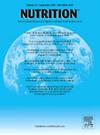Longitudinal changes in calf circumference and health outcomes among community-dwelling older adults in Southern Brazil
IF 3.2
3区 医学
Q2 NUTRITION & DIETETICS
引用次数: 0
Abstract
Objectives
Calf circumference (CC) is considered a simple proxy for muscle mass, one of the components of sarcopenia, but its relationship to health outcomes remains underexplored. This study examined the association between longitudinal CC changes and health-related outcomes among older adults in a Southern Brazilian city.
Methods
Longitudinal study using data of the COMO VAI? study, a cohort of older adults (> 60 years), that has been followed since 2014. CC was measured in 2014 and 2019, with participants categorized into stable CC (change within ±5% baseline value), decreased CC (change of less than −5%), and increased CC (change greater than +5%). The evaluated health-related outcomes were functional disability, self-reported falls, and the presence of frailty phenotype. Associations between CC changes and health-related outcomes were analyzed using Logistic regression, adjusting for potential confounders.
Results
Among the 498 participants with complete CC data in both follow-ups, the proportion of individuals whose CC decreased or increased was quite similar (11.8% for decrease and 11.2% for increase). The oldest participants (≥ 80 years) and those with lower socioeconomic status were at greater risk of CC decrease between 2014 and 2019. CC decrease was associated with a higher odds of functional disability (OR = 2.39; 95% CI: 1.27–4.50) and frailty (OR = 7.48; 95% CI: 3.18–17.57). No significant association was found between CC changes and falls.
Conclusion
Declining CC was significantly associated with functional disability and frailty phenotype in older Brazilian adults.
巴西南部社区老年人小腿围的纵向变化和健康结果
目的小腿围(CC)被认为是肌肉质量的简单代表,肌肉质量是肌肉减少症的组成部分之一,但其与健康结果的关系仍未得到充分探讨。本研究调查了巴西南部城市老年人的纵向CC变化与健康相关结果之间的关系。方法采用COMO VAI?研究中,一组老年人(>;60年),自2014年以来一直如此。在2014年和2019年测量CC,参与者分为稳定CC(变化在±5%的基线值内),减少CC(变化小于- 5%)和增加CC(变化大于+5%)。评估的健康相关结果是功能障碍、自我报告跌倒和虚弱表型的存在。使用逻辑回归分析CC变化与健康相关结果之间的关联,调整潜在混杂因素。结果在两次随访的498名CC数据完整的参与者中,CC下降或增加的个体比例非常相似(下降11.8%,增加11.2%)。2014年至2019年期间,年龄最大的参与者(≥80岁)和社会经济地位较低的参与者CC下降的风险更大。CC降低与功能性残疾的高几率相关(OR = 2.39;95% CI: 1.27-4.50)和虚弱(OR = 7.48;95% ci: 3.18-17.57)。CC变化和跌倒之间没有明显的关联。结论:CC下降与巴西老年人的功能残疾和虚弱表型显著相关。
本文章由计算机程序翻译,如有差异,请以英文原文为准。
求助全文
约1分钟内获得全文
求助全文
来源期刊

Nutrition
医学-营养学
CiteScore
7.80
自引率
2.30%
发文量
300
审稿时长
60 days
期刊介绍:
Nutrition has an open access mirror journal Nutrition: X, sharing the same aims and scope, editorial team, submission system and rigorous peer review.
Founded by Michael M. Meguid in the early 1980''s, Nutrition presents advances in nutrition research and science, informs its readers on new and advancing technologies and data in clinical nutrition practice, encourages the application of outcomes research and meta-analyses to problems in patient-related nutrition; and seeks to help clarify and set the research, policy and practice agenda for nutrition science to enhance human well-being in the years ahead.
 求助内容:
求助内容: 应助结果提醒方式:
应助结果提醒方式:


